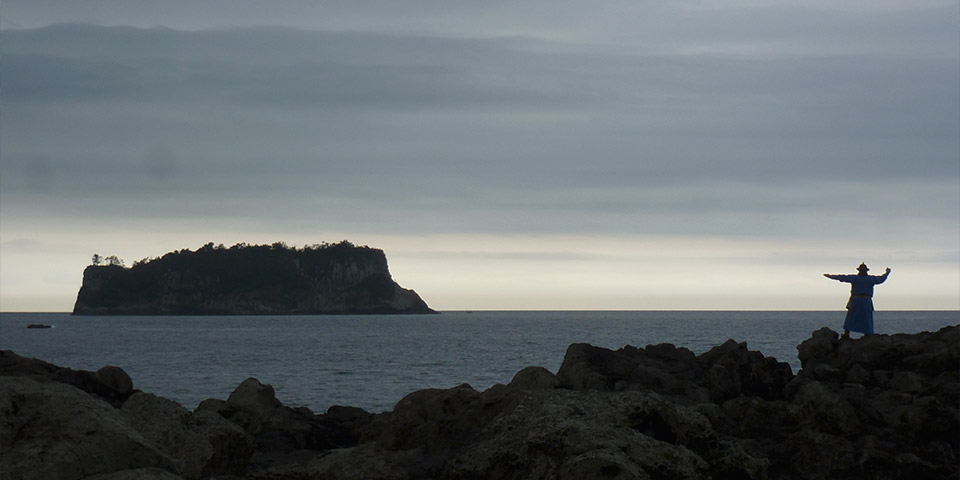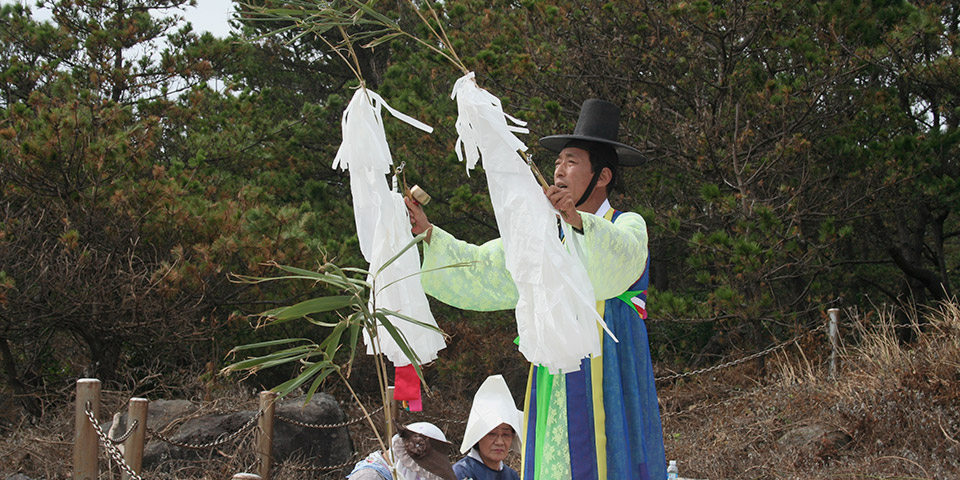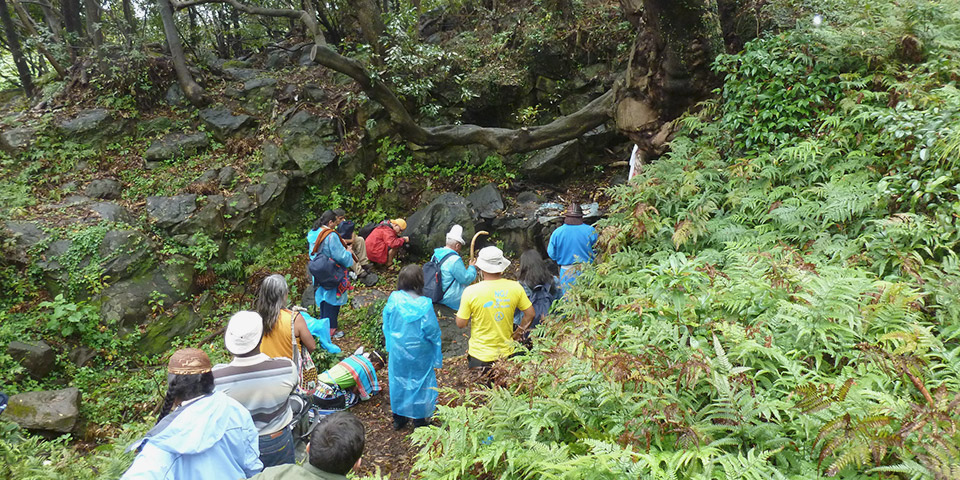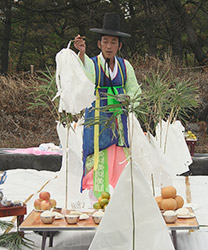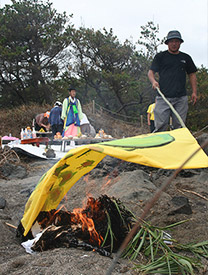ಸೈಟ್
ಗ್ಯಾಂಗ್ಜಿಯೋನ್ ಗ್ರಾಮವು ದಕ್ಷಿಣ ಕೊರಿಯಾದ ಗಣರಾಜ್ಯದ ಜೆಜು ದ್ವೀಪದ ದಕ್ಷಿಣ ತೀರದಲ್ಲಿದೆ ಮತ್ತು ಇದು ಪ್ರಾರ್ಥನೆಯ ಮರದಂತಹ ಪ್ರಾಚೀನ ಪವಿತ್ರ ಸ್ಥಳಗಳಿಂದ ಆವೃತವಾಗಿದೆ., ಬಾವಿ ಮತ್ತು ಕರಾವಳಿ ಕಲ್ಲಿನ ರಚನೆಗಳು. ಗುರಿಂಬಿ ಅವರು ಎ 1.2 ಕಿಮೀ ಸರಂಧ್ರ ಆಂಡಿಸೈಟ್ ಮತ್ತು ಟ್ಯಾಚ್ಟಿಲೈಟ್ ರಾಕ್ ಕರಾವಳಿಯ ಕರಾವಳಿ ಪ್ರದೇಶ, ಈಗ ಹೆಚ್ಚಾಗಿ ನೇವಿ ಬೇಸ್ ಅಭಿವೃದ್ಧಿಯಿಂದ ಆಕ್ರಮಿಸಿಕೊಂಡಿದೆ. ಸಂಪೂರ್ಣ ಸೈಟ್ ತಲೆಮಾರುಗಳ ಉದ್ದಕ್ಕೂ ಪ್ರಾರ್ಥನೆ ಮತ್ತು ಆಚರಣೆಗಾಗಿ ಬಳಸಲ್ಪಟ್ಟಿದೆ ಎಂದು ತಿಳಿದಿದೆ, ವಿಶೇಷವಾಗಿ ಸಮೃದ್ಧಿಗಾಗಿ ಸಾಗರವನ್ನು ಪ್ರಾರ್ಥಿಸುವ ಸಮಾರಂಭಕ್ಕಾಗಿ. ಗುರಿಂಬಿಯ ಆಗ್ನೇಯ ತುದಿಯಲ್ಲಿ, ನೌಕಾಪಡೆಯ ನೆಲೆಯ ನಿರ್ಮಾಣದ ಹೊರತಾಗಿ ಗುರುತಿಸಲಾದ ದೇವಾಲಯವಿದೆ, ಇದನ್ನು ಯುಗಯುಗಾಂತರಗಳಿಂದ ವಾರ್ಷಿಕ ಪುರಸಭೆಯ ಸಮಾರಂಭಗಳಿಗೆ ಬಳಸಲಾಗುತ್ತದೆ. ನೌಕಾಪಡೆಯ ನೆಲೆಯಿಂದ ಗ್ರಾಮ ಮತ್ತು ಅದರ ಸಂಸ್ಕೃತಿಯನ್ನು ರಕ್ಷಿಸಲು ಈ ಪ್ರದೇಶವು ಈಗ ಅಂತರರಾಷ್ಟ್ರೀಯ ಪ್ರತಿಭಟನೆಯ ಅಭಿಯಾನದ ಕೇಂದ್ರವಾಗಿದೆ.
"ಶಿಂಬಾಂಗ್ ಷಾಮನ್ ಎಲ್ಲಾ ಜೆಜುಗಳನ್ನು ಆಹ್ವಾನಿಸುತ್ತಾನೆ 18.000 ಚೋಗಂಜೆ ಸಮಾರಂಭವನ್ನು ನಡೆಸುವ ಸಲುವಾಗಿ ದೇವರು ಮತ್ತು ದೇವತೆಗಳನ್ನು ಪವಿತ್ರ ಸ್ಥಳದೊಳಗೆ. ಅವನು ದೇವರ ಕ್ಷೇತ್ರಕ್ಕೆ ದ್ವಾರವನ್ನು ತೆರೆಯುತ್ತಾನೆ, ಸಮಾರಂಭ ನಡೆಯುವ ಪವಿತ್ರ ಸ್ಥಳವನ್ನು ಶುದ್ಧೀಕರಿಸುತ್ತದೆ. ನಂತರ ಅವನು ದೇವರುಗಳನ್ನು ಸ್ಥಳಕ್ಕೆ ಕರೆದುಕೊಂಡು ಹೋಗಿ ತಮ್ಮ ಆಸನಗಳಲ್ಲಿ ಕೂರಿಸುತ್ತಾನೆ. ಅವರನ್ನು ಕುಳಿತ ನಂತರ, ಶಿಂಬಾಂಗ್ ಗ್ರಾಮಸ್ಥರ ಯೋಗಕ್ಷೇಮಕ್ಕಾಗಿ ಮತ್ತು ಗ್ಯಾಂಗ್ಜಿಯಾಂಗ್ ಅನ್ನು ಉಳಿಸಲು ಪ್ರಾರ್ಥಿಸುತ್ತಾನೆ.
- ಹಾಂಗ್ ಸುನೌಂಗ್: ತಮ್ನಾಗುಕ್ ಇಪ್ಚುನ್ ಗುಟ್ನೋರಿ ಉತ್ಸವದ ಸಂಶೋಧಕರು ಮತ್ತು ತಜ್ಞರು, ಮದ್ದು, ಜೆಜು ದ್ವೀಪ.
ಪವಿತ್ರ ಸ್ಥಳದ ಗಡಿಯಲ್ಲಿ ನೌಕಾಪಡೆಯ ನೆಲೆಯನ್ನು ನಿರ್ಮಿಸುವ ಮೂಲಕ ಗುರೊಂಬಿ ತೀವ್ರವಾಗಿ ಅಪಾಯದಲ್ಲಿದೆ. ನೌಕಾನೆಲೆ ಮುಗಿದರೆ ಗಂಗ್ಜಿಯೋನ್ ಗ್ರಾಮದ ಸುತ್ತಮುತ್ತಲಿನ ಅನೇಕ ಇತರ ಸೈಟ್ಗಳು ಹಳ್ಳಿಯಲ್ಲಿನ ಜೀವನಶೈಲಿಯನ್ನು ಬದಲಾಯಿಸುವುದರಿಂದ ಒತ್ತಡಕ್ಕೆ ಒಳಗಾಗುತ್ತವೆ.. ಗುರೊಂಬಿಯ ಪವಿತ್ರ ಸ್ಥಳದಲ್ಲಿ ಸಮಾರಂಭಗಳನ್ನು ಸಾಂಪ್ರದಾಯಿಕವಾಗಿ ವಾರ್ಷಿಕ ಚಕ್ರಗಳಲ್ಲಿ ನಡೆಸಲಾಗುತ್ತದೆ, ನೌಕಾನೆಲೆಯ ನಿರ್ಮಾಣ ಕಾರ್ಯದಿಂದಾಗಿ ಇದು ಹಲವಾರು ವರ್ಷಗಳಿಂದ ಸಂಭವಿಸಲಿಲ್ಲ. ನೌಕಾಪಡೆಯ ನೆಲೆಯು ಕರಾವಳಿ ಯುನೆಸ್ಕೋ ಮ್ಯಾನ್ ಮತ್ತು ಬಯೋಸ್ಫಿಯರ್ ರಿಸರ್ವ್ನ ಭಾಗವನ್ನು ಛೇದಿಸುತ್ತದೆ ಮತ್ತು ಅಳಿವಿನಂಚಿನಲ್ಲಿರುವ ಹವಳಗಳನ್ನು ಒಳಗೊಂಡಂತೆ ವಿಶ್ವದ ದೊಡ್ಡ ಮೃದುವಾದ ಹವಳದ ಉದ್ಯಾನಗಳಲ್ಲಿ ಒಂದಾಗಿದೆ., ಏಡಿಗಳು, ಕಪ್ಪೆಗಳು ಮತ್ತು ಸೀಗಡಿಗಳು ಹಾಗೂ ಇಂಡೋ-ಪೆಸಿಫಿಕ್ ಬಾಟಲ್ನೋಸ್ ಡಾಲ್ಫಿನ್ (ಟರ್ಸಿಯಾಪ್ಸ್ ಅಡುಂಕಸ್) (ಎಲ್ಲಿಸ್ ಮತ್ತು ಇತರರು 2012).
ಉಸ್ತುವಾರಿ ಸಾವಿರಾರು ವರ್ಷಗಳಿಂದ, ನೃತ್ಯಗಳು ಕೊರಿಯಾದಲ್ಲಿ ಸಾಂಪ್ರದಾಯಿಕ ಧಾರ್ಮಿಕ ಸಮಾರಂಭಗಳಲ್ಲಿ ಬಹುಪಾಲು ಭಾಗವಾಗಿದೆ ಎಂದು ಕರೆಯಲ್ಪಡುವ ಸಮಾರಂಭದಲ್ಲಿ ಎಲ್ಲಾ ವಯಸ್ಸಿನ ಕೊರಿಯನ್ ಪುರುಷರು ಮತ್ತು ಮಹಿಳೆಯರು ಹಲವಾರು ದಿನಗಳು ಮತ್ತು ರಾತ್ರಿಗಳವರೆಗೆ ಅಭ್ಯಾಸ ಮಾಡುತ್ತಾರೆ., ಕರುಳು ('ಗಟರ್' ಎಂದು ಉಚ್ಚರಿಸಲಾಗುತ್ತದೆ). ಕರುಳಿನ ವಿಧಗಳು ಅವರು ಉದ್ದೇಶಿಸಿರುವ ಸಂದರ್ಭಕ್ಕೆ ಅನುಗುಣವಾಗಿ ಭಿನ್ನವಾಗಿರುತ್ತವೆ, ಆದರೆ ಮುಖ್ಯ ವಿಧಗಳು ದೇಶೀಯ ಸಂತೋಷಕ್ಕಾಗಿ ಪ್ರಾರ್ಥಿಸುತ್ತಿವೆ, ಸತ್ತವರ ಆತ್ಮಗಳನ್ನು ಇತರ ಜಗತ್ತಿಗೆ ರವಾನಿಸಲು ಸಹಾಯ ಮಾಡುತ್ತದೆ, ಮತ್ತು ಸ್ಥಳೀಯ ಸಮುದಾಯದ ಏಳಿಗೆಗಾಗಿ ಪ್ರಾರ್ಥಿಸಲು. ಆಧುನೀಕರಣದೊಂದಿಗೆ ಕರುಳಿನ ಅನೇಕ ಅಭಿವ್ಯಕ್ತಿಗಳು ಕಳೆದುಹೋಗಿವೆ ಮತ್ತು ಶಾಮನ್ನರು ವ್ಯವಸ್ಥಿತವಾಗಿ ಸರ್ಕಾರದಿಂದ ಅಂಚಿನಲ್ಲಿದ್ದಾರೆ, ಅವರನ್ನು ಮೂಢನಂಬಿಕೆ ಮತ್ತು ಅಜ್ಞಾನಿಗಳೆಂದು ಬ್ರಾಂಡ್ ಮಾಡುವುದು. ಮೀಸಲಾದ ಪವಿತ್ರ ಸ್ಥಳದಲ್ಲಿ ಸಮಾರಂಭದ ಪ್ರಗತಿಯನ್ನು ಹಾಡು ಮತ್ತು ನೃತ್ಯದ ಮೂಲಕ ನಿರ್ದೇಶಿಸುವುದು ಶಾಮನ್ನರು.. ಸಮಾರಂಭವನ್ನು ಮುನ್ನಡೆಸುವ ಶಾಮನ್ನರು ಶಿನ್ ಗಟ್ ಮೂಲಕ ಶಾಮನ್ನರಾಗುತ್ತಾರೆ 15 ದಿನವಿಡೀ ಭವ್ಯವಾದ ಶಾಮನಿಸ್ಟಿಕ್ ಆಚರಣೆ. ಗ್ರಾಮದ ಇತರ ಅನೇಕ ಜನರು ಸಹ ಕರುಳಿನಲ್ಲಿ ಪಾಲ್ಗೊಳ್ಳುತ್ತಾರೆ ಮತ್ತು ಸೈಟ್ ಅನ್ನು ಸ್ವಚ್ಛಗೊಳಿಸುವ ಮತ್ತು ಸಿದ್ಧಪಡಿಸುವ ನಿರ್ದಿಷ್ಟ ಪಾತ್ರಗಳನ್ನು ಹೊಂದಿದ್ದಾರೆ, ಸಂಗೀತವನ್ನು ಒದಗಿಸುವುದು ಮತ್ತು ಕೊಡುಗೆಗಳನ್ನು ನೀಡುವುದು.
ವಿಷನ್ ಮೋಟ್ಪುರಿಯಲ್ಲಿರುವ ದೇವಾಲಯದಂತಹ ಪವಿತ್ರ ಸ್ಥಳಗಳು ಗಂಗ್ಜಿಯೋನ್ ಗ್ರಾಮದ ಸುತ್ತಮುತ್ತಲಿನ ಪರಿಸರಕ್ಕೆ ಸಂಬಂಧಿಸಿವೆ.. ಇದು ಹಳ್ಳಿಗರು ಮತ್ತು ಈ ವಿಶೇಷ ಸ್ಥಳಗಳನ್ನು ನೋಡಿಕೊಳ್ಳುವ ಶಾಮನ್ನರ ಸಾಮಾಜಿಕ-ಸಾಂಸ್ಕೃತಿಕ ಜೀವನದ ಆಂತರಿಕ ಭಾಗವಾಗಿದೆ.. ನೌಕಾ ನೆಲೆಯು ಗ್ರಾಮಕ್ಕೆ ಅಪಾಯವನ್ನುಂಟುಮಾಡುವುದರೊಂದಿಗೆ ಜನರ ಪೂರ್ವಜರೊಂದಿಗೆ ಸಂಬಂಧವನ್ನು ಕಾಪಾಡಿಕೊಳ್ಳಲು ಬಳಸುವ ಪವಿತ್ರ ನೈಸರ್ಗಿಕ ತಾಣಗಳು ಸಹ ಅಪಾಯದಲ್ಲಿದೆ.. ನೌಕಾನೆಲೆಯನ್ನು ನಿಲ್ಲಿಸಬೇಕು ಮತ್ತು ತೆಗೆದುಹಾಕಬೇಕು ಮತ್ತು ಗ್ರಾಮವು ಅದರ ಹಿಂದಿನ ಶಾಂತಿಯನ್ನು ಆಶ್ರಯಿಸಬೇಕು, ಇದರಿಂದ ಸಂಸ್ಕೃತಿ ಮತ್ತು ಪ್ರಕೃತಿ ಮತ್ತೊಮ್ಮೆ ಪ್ರವರ್ಧಮಾನಕ್ಕೆ ಬರಬೇಕು ಎಂಬುದು ಹೆಚ್ಚಿನ ಗ್ರಾಮಸ್ಥರ ಪ್ರಾಥಮಿಕ ಕಾಳಜಿಯಾಗಿದೆ..
"ಯೊವಾಂಗ್ಮಾಜಿಯು ಸಮುದ್ರವನ್ನು ನಿಯಂತ್ರಿಸುತ್ತದೆ ಎಂದು ನಂಬಲಾದ ಯೊವಾಂಗ್ ಡ್ರ್ಯಾಗನ್ ಕಿಂಗ್ಗೆ ಸ್ವಾಗತ ಸಮಾರಂಭವಾಗಿದೆ. ಯೋವಾಂಗ್ಮಾಜಿಯಲ್ಲಿ ಉಪ ಸಮಾರಂಭವಾಗಿ, Yowangjilchim ಯೊವಾಂಗ್ ಮತ್ತು ಅಥವಾ ಸಮುದ್ರದಲ್ಲಿ ಮರಣ ಹೊಂದಿದ ಎಲ್ಲಾ ಸತ್ತವರಿಗೆ ದಾರಿ ಮಾಡಿಕೊಡುವ ಸಮಾರಂಭವಾಗಿದೆ, ಮತ್ತು ಅವರು ಗಂಗ್ಜಿಯೊಂಗ್ ಗ್ರಾಮವನ್ನು ರಕ್ಷಿಸುತ್ತಿರುವಾಗ ಮರಣಹೊಂದಿದರು. ಅವರನ್ನು ಧಾರ್ಮಿಕ ಸ್ಥಳದಲ್ಲಿ ಕೂರಿಸಿದ ನಂತರ, ಶಿಂಬಾಂಗ್ ಶಾಮನ್ ಹಳ್ಳಿಗರ ಯೋಗಕ್ಷೇಮಕ್ಕಾಗಿ ಮತ್ತು ಗ್ಯಾಂಗ್ಜಿಯಾಂಗ್ ಅನ್ನು ಉಳಿಸಲು ಪ್ರಾರ್ಥಿಸುತ್ತಾನೆ.
- ಹಾಂಗ್ ಸುನೌಂಗ್: ತಮ್ನಾಗುಕ್ ಇಪ್ಚುನ್ ಗುಟ್ನೋರಿ ಉತ್ಸವದ ಸಂಶೋಧಕರು ಮತ್ತು ತಜ್ಞರು, ಮದ್ದು, ಜೆಜು ದ್ವೀಪ.
ಸಮ್ಮಿಶ್ರ ಸ್ಥಳೀಯ ಜನರು ಅನೇಕ ರಾಷ್ಟ್ರೀಯ ಮತ್ತು ಅಂತರಾಷ್ಟ್ರೀಯ ಬೆಂಬಲಿಗರೊಂದಿಗೆ ಗ್ಯಾಂಗ್ಜಿಯೋನ್ ಗ್ರಾಮದಲ್ಲಿ ನೌಕಾಪಡೆಯ ವಿರುದ್ಧ ಚಳುವಳಿಗೆ ಕೈಜೋಡಿಸಿದ್ದಾರೆ "ಈಗ ಸುರಕ್ಷಿತ ಜೆಜು". ಆದಾಗ್ಯೂ, ಪವಿತ್ರ ನೈಸರ್ಗಿಕ ತಾಣಗಳ ರಕ್ಷಣೆಯನ್ನು ಸ್ಥಳೀಯ ರಕ್ಷಕರ ಕೈಯಲ್ಲಿ ಇರಿಸಲಾಗುತ್ತದೆ, ಸಂಬಂಧಪಟ್ಟ ಗ್ರಾಮಸ್ಥರು ಮತ್ತು ಶಾಮನ್ನರು. ಪಾಲಕರು ಮತ್ತು ಕ್ರಿಯಾ ಸಮಿತಿ ದೊಡ್ಡ ಉದ್ದೇಶಕ್ಕಾಗಿ ಕೈಜೋಡಿಸಿದೆ, ಇದು ನೌಕಾಪಡೆಯ ನೆಲೆಯನ್ನು ವಿರೋಧಿಸುವ ಮೂಲಕ ಗಂಗ್ಜಿಯೋನ್ ಗ್ರಾಮದ ಸಂರಕ್ಷಣೆಯಾಗಿದೆ. ಆಚರಣೆಯ ಅಂಶಗಳ ಪುನರುಜ್ಜೀವನ ಮತ್ತು ಮುಂದುವರಿಕೆಗೆ ಸಂಬಂಧಿಸಿದ ಬೆಂಬಲವನ್ನು ಕ್ಯುಂಗಟ್ ಸಂರಕ್ಷಣಾ ಸಮಿತಿ ಮತ್ತು ಹಲವಾರು ಸಂಶೋಧನಾ ಸಂಸ್ಥೆಗಳು ಮತ್ತು ವಿಶ್ವವಿದ್ಯಾಲಯಗಳ ಮೂಲಕ ಸುರಕ್ಷಿತಗೊಳಿಸಲಾಗಿದೆ..
ಕ್ರಿಯೆ
"ಸೇಫ್ ಜೆಜು ನೌ" ಕ್ರಿಯಾ ಸಮಿತಿಯು ದೊಡ್ಡ ಉದ್ಯಮಿಗಳಿಂದ ನೌಕಾಪಡೆಯ ನೆಲೆಯ ನಿರ್ಮಾಣದ ವಿರುದ್ಧ ನಿರಂತರವಾಗಿ ಹೋರಾಡುತ್ತಿದೆ, ಕೊರಿಯನ್ ಮತ್ತು US ಸರ್ಕಾರಗಳು. ಗ್ಯಾಂಗ್ಜಿಯೋನ್ ಗ್ರಾಮಸ್ಥರ ಆಧ್ಯಾತ್ಮಿಕ ಯೋಗಕ್ಷೇಮವನ್ನು ಬಲಪಡಿಸುವ ಸಲುವಾಗಿ ಸಲ್ಲಿಮ್ ಕರುಳು ಎಂಬ ಗಂಗ್ಜಿಯೋನ್ ಗ್ರಾಮವನ್ನು ಉಳಿಸುವ ಬೆಂಕಿ ಸಮಾರಂಭವನ್ನು ಸೆಪ್ಟೆಂಬರ್ 5 ರಂದು ನಡೆಸಲಾಯಿತು. 2012, ಮೋಟ್ಪುರಿ ದೇಗುಲದಲ್ಲಿ. ಸೆಪ್ಟೆಂಬರ್ನಲ್ಲಿ 2012, ಅಂತರಾಷ್ಟ್ರೀಯ ಪಾಲಕರ ಗುಂಪು, IUCN ವಿಶ್ವ ಸಂರಕ್ಷಣಾ ಕಾಂಗ್ರೆಸ್ಗೆ ಭೇಟಿ ನೀಡಿದ ಶಾಮನ್ನರು ಮತ್ತು ಆಧ್ಯಾತ್ಮಿಕ ನಾಯಕರು ಗುರಿಂಬಿ ಮತ್ತು ಗ್ಯಾಂಗ್ಜಿಯೋನ್ ಗ್ರಾಮದ ಸುತ್ತಮುತ್ತಲಿನ ಇತರ ಪವಿತ್ರ ನೈಸರ್ಗಿಕ ಸ್ಥಳಗಳಲ್ಲಿ ಸಮಾರಂಭವನ್ನು ನಡೆಸಿದರು. ಸಾಮಾಜಿಕ ಮತ್ತು ಆಧ್ಯಾತ್ಮಿಕ ದೃಷ್ಟಿಕೋನದಿಂದ ಹಳ್ಳಿಯ ಸುತ್ತಲಿನ ಪವಿತ್ರ ನೈಸರ್ಗಿಕ ತಾಣಗಳು ಹಳ್ಳಿಯಲ್ಲಿನ ಕೋಮು ಜೀವನದ ಪ್ರಮುಖ ಭಾಗವಾಗಿದೆ ಮತ್ತು ಅದರ ಅಸ್ತಿತ್ವಕ್ಕಾಗಿ ಹೋರಾಟ.
ಸಂರಕ್ಷಣಾ ಉಪಕರಣಗಳುಗಂಗ್ಜಿಯೋನ್ ಗ್ರಾಮದ ಸುತ್ತಮುತ್ತಲಿನ ಪವಿತ್ರ ನೈಸರ್ಗಿಕ ತಾಣಗಳು ಗ್ರಾಮಸ್ಥರು ಮತ್ತು ಶಾಮನ್ನರಿಗೆ ತಿಳಿದಿವೆ, ಅವರು ಅವುಗಳನ್ನು ಪ್ರಾರ್ಥನೆ ಮತ್ತು ಸಮಾರಂಭಕ್ಕಾಗಿ ಬಳಸುತ್ತಾರೆ ಆದರೆ ಅನೇಕರು ಅಧಿಕೃತವಾಗಿ ನೋಂದಾಯಿಸಲ್ಪಟ್ಟಿಲ್ಲ.. ಕೆಲವು ಸೈಟ್ಗಳನ್ನು ಯುವ ಪೀಳಿಗೆಯವರು ಕಡಿಮೆ ಬಾರಿ ಭೇಟಿ ನೀಡುತ್ತಾರೆ ಎಂದು ತಿಳಿದುಬಂದಿದೆ ಮತ್ತು ಸಾಮುದಾಯಿಕ ಜೀವನದಲ್ಲಿ ಪವಿತ್ರ ನೈಸರ್ಗಿಕ ತಾಣಗಳ ಪಾತ್ರಗಳನ್ನು ಭದ್ರಪಡಿಸುವ ಅಗತ್ಯತೆಯ ಸಾಮಾನ್ಯ ಗ್ರಹಿಕೆ ಇದೆ.. ಪವಿತ್ರ ಮರ ಮತ್ತು ಪವಿತ್ರ ವಸಂತದಂತಹ ಪವಿತ್ರ ನೈಸರ್ಗಿಕ ತಾಣಗಳು ನೈಸರ್ಗಿಕ ಸಂಪನ್ಮೂಲಗಳ ಸಂರಕ್ಷಣೆ ಮತ್ತು ಬಳಕೆಗೆ ಸಂಬಂಧಿಸಿದಂತೆ ಸ್ಥಳೀಯ ನಿಷೇಧಗಳು ಮತ್ತು ನಿಯಮಗಳ ರಚನೆಗೆ ಸಂಬಂಧಿಸಿವೆ..
ನೀತಿ ಹಾಗೂ ಕಾನೂನು
ಹಲವಾರು ಸರ್ಕಾರಿ ಏಜೆನ್ಸಿಗಳು ಸಾಂಸ್ಕೃತಿಕ ಆಡಳಿತದಲ್ಲಿ ತೊಡಗಿಕೊಂಡಿವೆ ಮತ್ತು ಆದ್ದರಿಂದ ಕೆಲವು ಪವಿತ್ರ ಸ್ಥಳಗಳು ಉದಾಹರಣೆಗೆ ಸಾಂಸ್ಕೃತಿಕ ಪರಂಪರೆಯ ಆಡಳಿತದ ಅಡಿಯಲ್ಲಿ ಸಾಂಸ್ಕೃತಿಕ ಪರಂಪರೆಯ ರಾಷ್ಟ್ರೀಯ ಸಂಶೋಧನಾ ಸಂಸ್ಥೆ (CHA). CHA ಆದಾಗ್ಯೂ ಗ್ಯಾಂಗ್ಜಿಯೋನ್ ಹಳ್ಳಿಯಿಂದ ಪದೇ ಪದೇ ಮನವಿ ಮಾಡಿದರೂ ಸೈಟ್ನ ಕೆಲವು ಭಾಗಗಳಲ್ಲಿ ಕಂಚಿನ ಯುಗದ ಅವಶೇಷಗಳ ಉತ್ಖನನಗಳು ಇನ್ನೂ ನಡೆಯುತ್ತಿದ್ದಾಗ ನೇವಿ ಬೇಸ್ ನಿರ್ಮಾಣವನ್ನು ಬೆಂಬಲಿಸುತ್ತದೆ. ಅಂತರಾಷ್ಟ್ರೀಯ ಒಪ್ಪಂದದ ಪ್ರಕಾರ ಸಮುದ್ರ ಪರಿಸರದ ಪಕ್ಕದ ಮತ್ತು ನೌಕಾಪಡೆಯ ಬೇಸ್ ಅಭಿವೃದ್ಧಿಯೊಂದಿಗೆ ಛೇದಿಸುವ ಕೆಲವು ಹಂತಗಳಲ್ಲಿ ಯುನೆಸ್ಕೋ ಮ್ಯಾನ್ ಮತ್ತು ಬಯೋಸ್ಫಿಯರ್ ರಿಸರ್ವ್ ಎಂದು ಗುರುತಿಸಲ್ಪಟ್ಟಿದೆ..
ಫಲಿತಾಂಶಗಳುಗ್ಯಾಂಗ್ಜಿಯೋನ್ ಗ್ರಾಮದ ಸುತ್ತಲಿನ ಪವಿತ್ರ ನೈಸರ್ಗಿಕ ತಾಣಗಳು ಗ್ಯಾಂಗ್ಜಿಯೋನ್ ಗ್ರಾಮವನ್ನು ನೇವಿ ಬೇಸ್ ನಿರ್ಮಾಣದಿಂದ ಉಳಿಸುವ ಹೋರಾಟಕ್ಕೆ ಪ್ರಮುಖ ಆಧ್ಯಾತ್ಮಿಕ ಮತ್ತು ಸಾಮುದಾಯಿಕ ಕೊಡುಗೆಯನ್ನು ನೀಡುತ್ತವೆ.. ಅವರು ಜೆಜು ದ್ವೀಪದಲ್ಲಿ ಸಾಂಸ್ಕೃತಿಕ ಮತ್ತು ಪರಿಸರ ಚಳವಳಿಯಿಂದ ಮತ್ತು ಕೊರಿಯಾದ ಮುಖ್ಯ ಭೂಭಾಗ ಮತ್ತು ಇತರ ದೇಶಗಳಿಂದ ಬೆಂಬಲವನ್ನು ರಚಿಸಿದ್ದಾರೆ.. ಈ ಸಾಂಸ್ಕೃತಿಕ ಮತ್ತು ಪರಿಸರ ಚಳುವಳಿಗಳ ಮೂಲಕ ಗ್ಯಾಂಗ್ಜಿಯೋನ್ ಗ್ರಾಮ ಮತ್ತು ಅದರ ಪವಿತ್ರ ನೈಸರ್ಗಿಕ ತಾಣಗಳ ಹೋರಾಟವು ಯುನೆಸ್ಕೋ ಮತ್ತು UNHCR ನಂತಹ ಅಂತರಾಷ್ಟ್ರೀಯ ಗೆಳೆಯರಿಂದ ಹೆಚ್ಚಿನ ಗಮನವನ್ನು ಪಡೆಯುತ್ತಿದೆ..
- ಜೆಜು ಉಳಿಸಲು ತುರ್ತು ಸಮಿತಿ: http://savejejunow.org/
- ಸುರಕ್ಷಿತ ಜುಜು ಸುದ್ದಿಪತ್ರಗಳನ್ನು ಓದಿ: http://savejejunow.org/newsletter/
- IUCN ಚಲನೆ 181 "ಜನರ ರಕ್ಷಣೆ, ಪ್ರಕೃತಿ, Gangjeong ಗ್ರಾಮದ ಸಂಸ್ಕೃತಿ ಮತ್ತು ಪರಂಪರೆ"
- ಎಲ್ಲಿಸ್, AS., ಸಂಗೀತ, ಕೆ., ಚಾ, I., ಯುನ್, ಎಸ್., ಬೇ, ಬಿ, ಕಿಮ್ ಆನ್, ಎಲ್. (2012) ಸ್ವತಂತ್ರ ಪರಿಸರ ಪ್ರಭಾವದ ಮೌಲ್ಯಮಾಪನ (EIA) ಗ್ಯಾಂಗ್ಜಿಯಾಂಗ್ ನೌಕಾ ನೆಲೆಯ ಉದ್ದೇಶಿತ ಸ್ಥಳವನ್ನು ಸುತ್ತುವರೆದಿರುವ ಕೋರಲ್ ಸಮುದಾಯಗಳು - ಹಿಂದಿನ ಸಂಶೋಧನೆ ಮತ್ತು ಸಂಶೋಧನೆಗಳ ವಿಶ್ಲೇಷಣೆ ಸೇರಿದಂತೆ
- IUCN ಯುನೆಸ್ಕೋದ ಕೊರಿಯನ್ ಆವೃತ್ತಿ "ಪವಿತ್ರವಾದ ಸ್ವಾಭಾವಿಕ ಸೈಟ್ಗಳು; ರಕ್ಷಿತ ಕ್ಷೇತ್ರ ವ್ಯವಸ್ಥಾಪಕರು ಮಾರ್ಗಸೂಚಿಗಳು" (ವೈಲ್ಡ್ ಮತ್ತು ಮ್ಯಾಕ್ಲಿಯೋಡ್)

